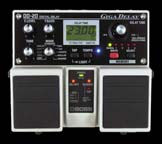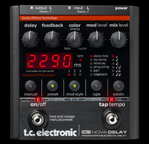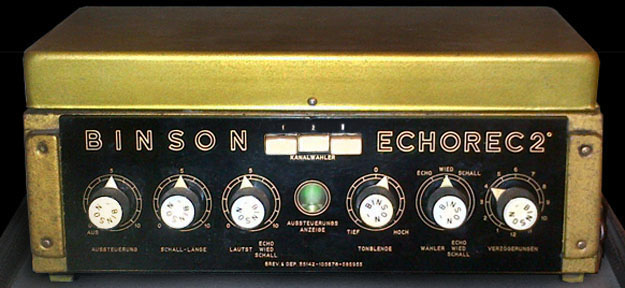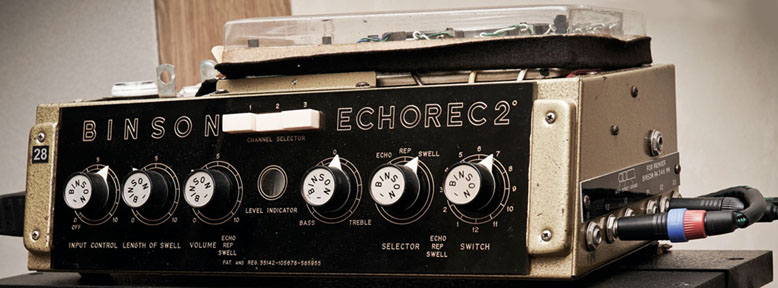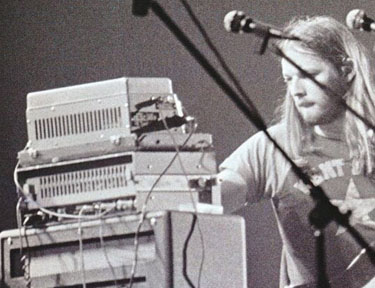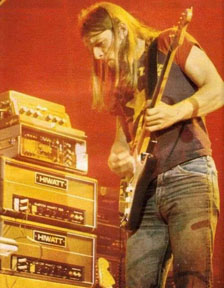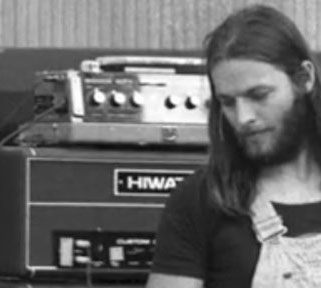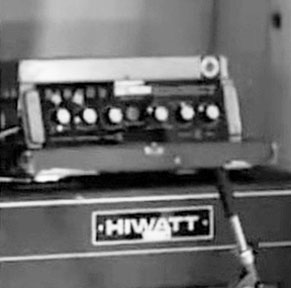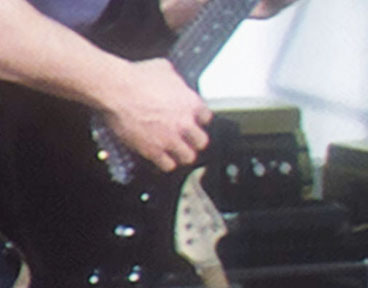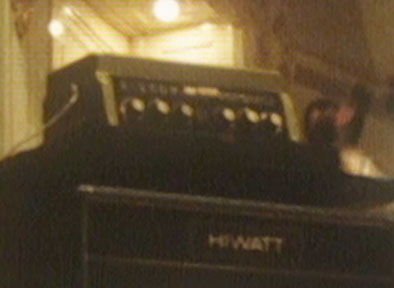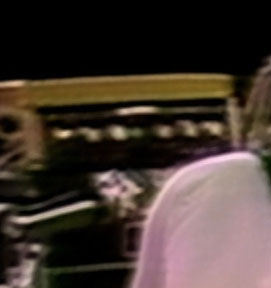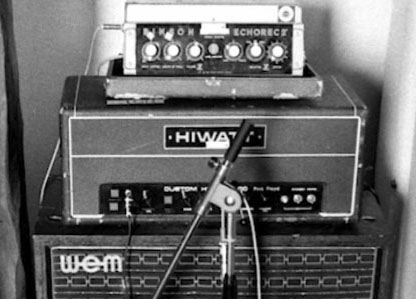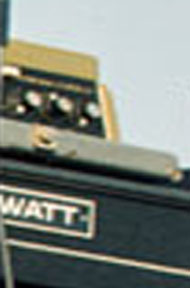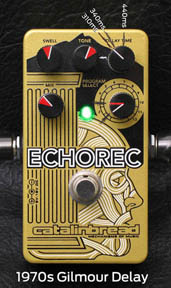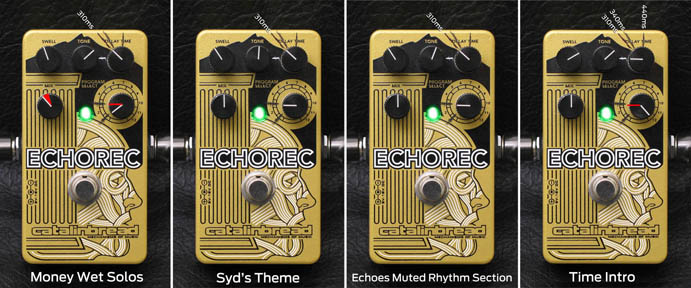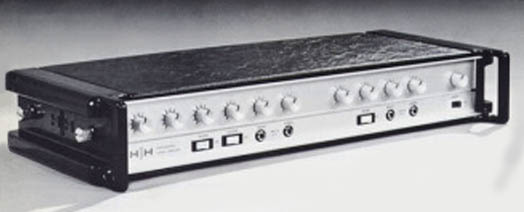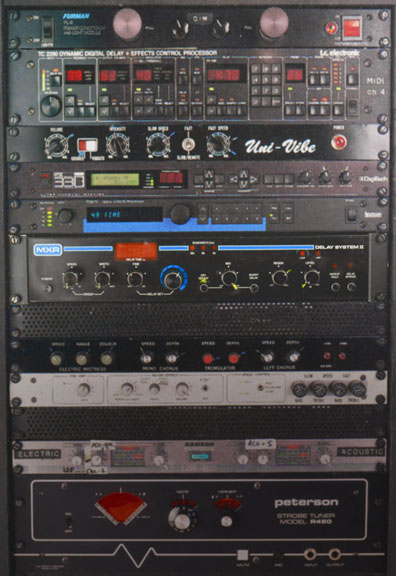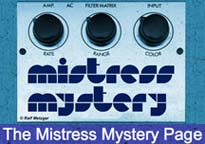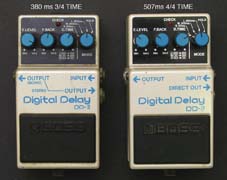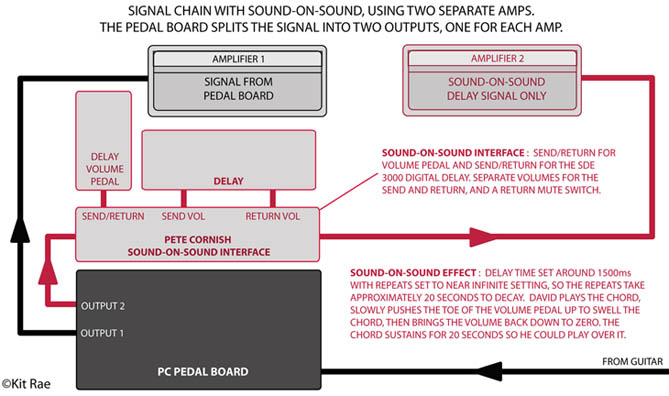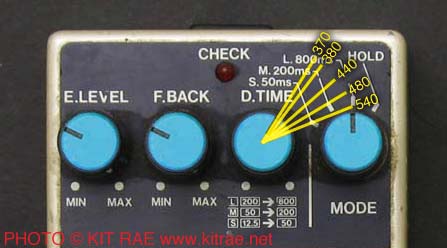NOTE: This website is frequently updated. Last update July 2023.
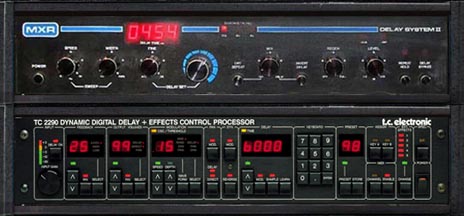
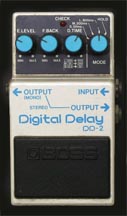
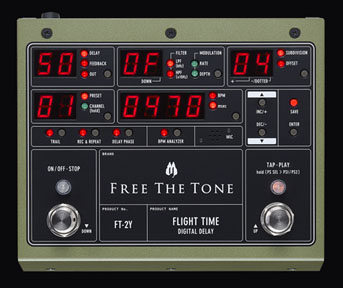
David often uses long echo delays to help create a his big, smooth, and liquidy solo tones. He used analog delays like the Binson Echorec throughout the 1970s and one has been seen in his Medina studio from 2013-2017. He began using digital delays in place of the Echorec around 1977. Some of the most used digital delays in his live rigs were the MXR 113 Digital Delay (1977-1986), the MXR 151 Digital Delay System II (1983-2016), the Boss DD-2 (1983-1986, 2006), the TC2290 Dynamic Digital Delay (1987-1994), and the Free The Tone Flight Time FT-1Y Digital Delay (2015-2017). Some songs require softer, warmer analog sounding repeats, and others require cleaner, more accurate digital delay repeats. David usually sets his delays in time with the song tempo, which helps hide the echo repeats. Sometimes he even uses two delays at once to create certain double tapped echo effects or to make a solo sound bigger. His delay times typically ranged from 300ms-550ms, with 5-8 repeats, but some songs required more specific delay times and settings, as detailed below.
A bit of delay can smooth out the unpleasant, raw frequencies you get from a fuzz box. - David Gilmour
DELAY SETTINGS - Some of Gilmour's most commonly used delay times are 300, 380, 440, 480, 540, and 630ms. Below is a link to a song-by-song list of Gilmour's delay settings, compiled from measuring the echo repeats in official releases and bootlegs of live recordings, and from delay times visible on the LCDs of his digital delays. Some duplicate the studio album delay times and some duplicate the live delay times.
DAVID GILMOUR DELAY TIME LIBRARY - Song by Song
DELAY TYPES - ANALOG AND DIGITAL - David has used numerous types of delays in his carreer, both analog and digital. There are so many different delays available now that it can be confusing to know which one is appropriate for Gilmour tones. With regards to the actual sound of the echo repeats, there are essentially two types of delays - analog and digital. Most analog type delays have a lower quality repeat decay that rolls off more high end on each repeat. Some even add an increasing warbly modulation to each repeat. Most digital delays create an accurate, pristine repeat that only decays in volume with each repeat, not in quality. Both types have been described as "warm" sounding, which can get confusing. Warm for an anlog delay usually refers to the high end roll-off decay, and warm for a digital delay usually means the repeats are not brighter or harsher than the original guitar signal, but are the same or have slightly less high end.
I use the MXR Digital Delay. I use one of their old ones most of the time because the width is narrower. If you get too high a quality bandwidth on a DDL you hear too much pinging and lose the sort of echo effect I use it for. Some are actually too high quality for my personal taste. My sound has everything to do with what sounds good to me. I don't care how I get it. - David Gilmour from Guitar for the Practicing Musician, 1985
We also have an old MXR DDL (MXR Digital Delay System II) digital delay unit built into a rack unit. It has a digital readout, but it's really nowhere close to being accurate. Dave likes it because even though it's a digital unit, it still sounds a little dirty, like a tape unit. - Phil Taylor, David's backline tech
The modulation feature that is common on modern analog and digital type delays is meant to simulate the sound of old analog tape delays as they aged. As the magnetic tape began to wear out and stretch over time, the repeats would start to degrade and sound dirty and warbly. This warble is similar to a light chorus or flanged sound, with high end roll-off. It's a beautiful sound, but David did not use tape delays like this. His main analog delays were nearly always the drum type, like the Echorec, which typically only had high end-roll. David maintained his Echorecs well so his sound only had minimal high end roll-off in the repeats and very little audible warble.
WHY CAN'T I HEAR THE ECHO REPEATS IN SOME GILMOUR/PINK FLOYD SOLOS? - David often has a big, watery delay tone, as if he were playing in a large hall, but the actual audible echo repeats in his solos are almost absent in many cases. It makes for a sound that really adds depth to the guitar tone in the mix, but is not cluttered by delay repeats. This is something us Gilmour fans have sought to recreate in our own playing. Using spring or digital reverb does not even get close, but some people struggle getting a delay pedal to sound right. So why don't you hear the repeats most of the time? There are several reasons.
1. The primary reason is becasue the delay time is usually set in time with the tempo of the song, so each repeat lands on the beat. When you have a drum and bass note landing at the same time it somewhat masks the repeat. The delay volume is often not very loud in the studio recordings, so in a full band context, the other instruments mask the repeats.
For example, I compared the 5.1 surround sound mix of the second On an Island solo with the solo in Castellorizon (from David's 2006 On an Island album). Based on what I hear the guitar delay levels are not much different in either song, but I noticed the delay repeats are very clear in Castellorizon, but I barely hear them in OAI . This is because the orchestra in Castellorizon is not loud enough to mask the repeats, but the band playing under the solo in On an Island certainly is. If you listen to a song where the band is not playing at all, like intro to Pink Floyd's Coming Back to Life, the delay repeats are very clear.
2. David has often usied very long delay times, so the repeats are not as obvious because he is playing the next bit of a solo phrase right when the repeats from the previous notes start. Shorter delay times are more obvious because the repeats are heard in between notes and phrases. Try playing the Comfortably Numb solo with a 380ms delay with 4-6 repeats, versus a longer 540-600ms delay to hear the difference. Occasionally David may be using a long repeat time on one delay, and a shorter repeat time on another delay simultaneously. The shorter delay fills in the gaps between the longer delay repeats, creating a smooth delay sound, but the delay time on both makes the repeats fall inline with the song tempo. There are also instances where he has had a long delay time, but only one or two repeats, which gives the big sound, but makes the repeats almost inaudible in the band mix.
3. If you are playing at home on your amp with delay, the delay sound will be much more apparent than when you are playing with a full band, where the delay repeats will blend in the band mix much better. Record yourself playing alone verses playing along with a backing track to see what I mean. When playing alone, I find I often turn the delay volume down, but with a band or backing track I turn it up.
4. In some of the studio recordings you are hearing the guitar delay and room sound or studio reverb, not just delay. An examination of the individual tracks from some of the 5.1 surround sound studio album releases reveals both were used. The reverb could have been added in the mixing stage, or it could be natural room reverb from mics positioned in the recording studio to capture the natural room sound. Regardless, it is the combination of both delay and reverb that makes the delay sound so smooth in some instances. Note that I am not talking about spring or amp reverb, or a reverb pedal, which is a completely different sound.
5. The official live recordings often have an even larger delay sound than the studio versions. You should keep in mind that these official recordings have been sweetened to sound as good as possible. I'm not saying David sounds nothing like this live, but you are hearing the natural hall or stadium reverb of the venue in these recordings and in many cases, studio reverb added in the mixing stage. Listen to some of the 5.1 live tracks separately and you can clearly hear this. If you listen to some of the better bootleg recordings and compare them to the official live releases, you will find David's real live sound is typically drier, with less delay. Often during the live songs that do have very loud delays, you do hear the repeats clearly.
HOW DO I REPLICATE THAT SMOOTH GILMOUR DELAY SOUND? - Be sure to read the section above. The best way I have found to create the smoothest delay is to simply set it in time with the song tempo. Another option is to run two delay pedals simultaneously. One set for a slighly shorter delay time, and a lower echo repeat volume, running into a longer delay with a slightly louder echo repeat will give you a very smooth sound. Even better is to run the delays parallel so one delay does not repeat the other, which sometimes sound messy. It helps to have the echo repeats of the first delay fall right in between, or on the repeats of the second delay, so it has a rhtmic feel. Too much volume from the first delay will make a mess of double tapped delay sounds on the second, so be careful not to over do it.
REVERB OR NO REVERB ? - In general, no - but sometimes, yes. David almost always uses delays in his live rigs, not reverbs. For the studio albums however, there is definitely reverb in many of the recordings, and in some cases much more so than delay. I am not talking about spring reverb from an amp. I am talking about the natural reverb sound of the room or hall the amplifier or speaker cabinet was recorded in, or studio reverb added to simulate it. I have split the 5.1 stem channels apart from the surround sound mixes of all of the Pink Floyd and Gilmour's solo albums to hear the individual elements. I often hear a guitar + delay track, a reverb only track, and sometimes the guitar recorded dry. The delay and reverb are usually not mixed particularly loud, but the overall combined wet delay/reverb mix is very effective.
For real room reverb, mics were placed in different parts of the recording studio to capture the room sound, not just the speaker cabinet from the amp. Reverb was also added at the mixing desk when recording or mixing. Pink Floyd recording engineer Andy Jackson has said he usually uses a couple of EMT plate reverbs in the studio for David's voice and guitar, and sometimes a Lexicon Hall reverb. There is an EMT 140 plate reverb on David's floating Astoria recording studio and the four famous EMT 140 plate reverbs at Abbey Road studios can be heard on early Pink Floyd recordings, especially Dark Side of the Moon. In fact, Dark Side engineer Alan Parsons said plate reverb was virtually the only reverb used for those recordings, although he has said they also used as many as five or six tape machines to create various reverb delays.
If you have a good sound in the room or hall you are playing in, there is no need to add reverb, but in small or dead sounding rooms, adding a small amount of reverb in your effects rig can really enhance the sound. Often what I hear in the recordings is just natural room or hall reverb. There are many effect pedals that simulate those sounds, and those types of simulated reverbs are also usually called plate, room, or hall reverb. The plate reverb sound is the best to use for Gilmour tones in my opinion, but minimally. It is best to have the reverb pedal last in your signal chain, and the trick is not to overdo it. Too much can severely alter your guitar tone before it hits the amp, washing out the definition and clarity. Note that reverb from a pedal in a guitar signal chain before the amp will never sound exactly the same as reverb added to recordings at the mixing desk, or mixed in later after the recording has been made. A pedal adds reverb before the signal hits the amplifier and speakers, so the reverb itself is amplified and prcessed by the amplifier circuitry. Adding reverb after the amplifier in the mix is more natural sounding because it is added post amplification, which is less tone altering.
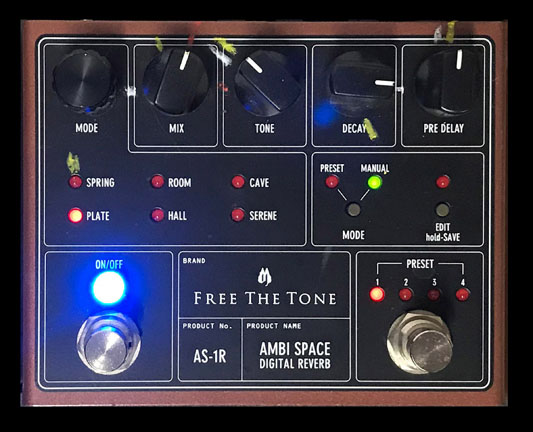
Plate Reverb settings on a Free The Tone Ambi Space stereo reverb pedal
I usually use a little plate reverb for clean or lightly overdriven guitar solos, but for some of the big concert hall sounds, like the Pulse live album mix, I will use more. When Pulse was mixed they were trying to replicate what it actually sounded like in the concert hall. I think a lot of hall reverb was added to the recording in post. Below are sound clips of me trying to replicate that concert hall reverb sound through two amps using a stereo delay and stereo reverb pedal. I used the plate reverb settings on a Free The Tone Ambi Space pedal. First are clips with and without the plate reverb, for reference.
![]() Shine on You Crazy Diamond Pulse style - delay only
Shine on You Crazy Diamond Pulse style - delay only
![]() Shine on You Crazy Diamond Pulse style - delay + plate reverb
Shine on You Crazy Diamond Pulse style - delay + plate reverb
As you can hear, the delay does most of the work, but the reverb adds to the scale of the concert hall sound. Here is a clip with the delay+reverb and a Pulse backing track.
![]() Shine on You Crazy Diamond Pulse style - EMG Strat > Boss CS-2 > Boss BD-2_Boss CE-2_Future Factory Stereo delay > Ambi Space stereo plate reverb > Reeves Custom 50 and Fender 59 Bassman LTD amps.
Shine on You Crazy Diamond Pulse style - EMG Strat > Boss CS-2 > Boss BD-2_Boss CE-2_Future Factory Stereo delay > Ambi Space stereo plate reverb > Reeves Custom 50 and Fender 59 Bassman LTD amps.
Below is another clip illustrating plate reverb from the Ambi Space reverb pedal. I turn each effect on one at a time so you can hear how they add to the tone.
![]() Coming Back to Life Intro Tone Build - Boss CS-2 and Dyncomp compressors first, then CE-2B chorus in left channel added, the delay added, then plate reverb added.
Coming Back to Life Intro Tone Build - Boss CS-2 and Dyncomp compressors first, then CE-2B chorus in left channel added, the delay added, then plate reverb added.
There are a few occasions where I have heard spring reverb in a Gilmour recording, but it is very rare. The first Money solo, for example, sounds like it is awash in spring reverb. Two guitars were multi tracked in the left and right channels. Alan Parsons has said David was generating all the effects himself for the first solo, so this was probably spring reverb from the Twin Reverb David had in the studio. The third solo also sounds like it has reverb, but that sounds more like room reverb or plate reverb added in the studio. Below is a breakdown switching between the various tracks of all three solos.
![]() Money solo multi track breakdown
Money solo multi track breakdown
Other than a few instances like that, reverb from David rig was not used and I do not recommend it. I have occasionally used spring reverb from an amplifier, but set very low so there is just a hint of that sound. Plate reverb is far more accurate. The Free the Tone Ambi Space pedal is my favorite device for this. I run it last in the signal chain and I almost always have a light plate reverb sound on when I play. I also use it to add some of the bigger room and concert hall sounds.
In order to use exact delay times it helps to have a delay with a digital display showing the time in miliseconds
HOW TO FIND THE PROPER DELAY TIMES - You can go here for a song-by-song list of Gilmour's delay times, but it is easy to find a delay time that works with a song tempo, even if you can't clearly hear the echo repeats when listening. I'll keep this simple rather than going into an explanation of time signatures. The simplest option is to use an online Beats Per Minute caculator, like this one. You just tap along to the song tempo with your keyboard and it calculates the BPM tempo for you. Then go to a website with a Delay Time Calculator, like the one on this page. Set the value to quarter notes, enter the BPM, and you have a delay time in milliseconds that is the same tempo as the song.
To do this by ear, turn the feedback on your delay up to around 80% or so, so the repeats are almost infinite. If you have a subdivisions setting (quarter notes, eighth notes, dotted eighth notes, et cetera) set it to quarter notes, or the normal setting. Set the delay time so the repeats are in time with the song tempo (beats per minute) or the drum beat. You want to to get one repeat for every beat. You can check this by mute picking a single note simultaneous with a drum beat, then listen to the repeats. If the repeats are faster than the tempo, increase the delay time. If the repeats are slower, reduce it. Fine tune it until you hear the repeats are exactly in sync with the song tempo. Once you have that, turn the feedback down so there are only about 3-6 repeats, adjust the delay volume to suit the song, and you are ready to go. If you have different subdivision settings on your delay, you can then try some of those as they will also be in time with the song tempo.
I change my echo settings fairly often in concert. I have two units, and I have different echo settings on both. There are times when I have both running at the same time for certain effects. I usually try, in solos, to set the DDLs to have some rhythmic time signature in common with the tune. Because the notes all intertwine, it doesn't matter anyway, but I find that I usually set them on a triplet. It's a sort of melodic delay to use. That may be just my fantasy; I don't know. That's another one of the personal esthetic judgments that you use in trying to get something to sound nice to yourself. - David from Guitar Player Magazine, November 1984
...I have a bunch of pedals - 4 DDL's - which I use in different combinations, MXR Digitals and the little Boss DD2's...I usually have one DDL with a short single slap on it. I have one for specific time settings, for things like Run Like Hell and Give Blood, so I know in numbers (delay time in milliseconds) what setting I need to use. I use the MXR with the read-out on it, so I instantly have the right tempo. Then I have two regular Boss units (DD2) which I set so one works in a triplet and the other in a 4/4 time - they're actually set in time with each other, so they combine and make a nice sound. When I'm recording I'll often set them in tempo to the track, so although they are just acting as an echo, the echo is rhythmic in away and has a triplet and the 4/4 beat in it. - David Gilmour interview by Bob Hewitt from Guitarist, June 1986
"TRIPLET" TIME DELAY - David has sometimes used a rhythmic 3/4 time delay, what he sometimes called "triplet" time. The repeats are in 3/4 time with the 4/4 time song tempo, adding a bouncy feel to the guitar. You can hear something similar to this technique used on the Meddle album from 1971, in the way David plays in time with the echo repeats in the buildup and arpeggio part of the second half of the song Echoes, below.
The first obvious use of David's triplet delay effect can be heard in One of These Days, the opening track on the Meddle album. David played the first bass guitar you hear and Roger Waters played the second that comes in immediately after. Both guitars have a 300ms echo repeat.
![]() One of These Days - bass excerpt
One of These Days - bass excerpt
David continued to use and refine this technique throughout his career. It can be heard in songs like Short and Sweet, Another Brick in the Wall Parts I and III, Run Like Hell, Blue Light, Give Blood, One Slip, Keep Talking, Take it Back, and Allons-Y.
This is actually not quarter-note triplets. David probably just uses the term triplet because what he does has a similar feel. It is actually dotted-eighth-notes, or one eighth note followed by two sixteenth notes. It sounds very complex because the delay is filling in and creating a rhythm in between the notes David plays, but it is actually rather simple to do. David could play a rhythm part, then jump to a chord or phrase while that delay rhythm repeated, then jump back to the delay rhythm before the repeats stopped. The effect almost sounds as if there are two guitars playing. It takes some practice, and you have to be very precise with your timing or you can easily get out of step with the song tempo. The delay time must also be precisely in time with the song tempo.
FINDING THE TRIPLET TIME DELAY FOR A SONG - If you want this delay sound and have a delay that shows the time in milliseconds, follow these steps. Find the proper delay time for the song as described above, then let's do some "Echorec math". Multiply that number by 75% to get the triplet time delay. Example: You determine the 4/4 beat/song tempo is 600ms. Multiply 600 x 75% to get the triplet time delay of 450ms (or divide 600 by 4 to get the quarter note time of 150ms, multiply that X3 for a triplet time, which equals 450ms). You can change the feel of the delay repeats by cutting the 600ms delay time in half to 300ms, 1/4 time to 150ms, or double it to 1200ms, et cetera. All those divisions and subdivisions will be in time with the song.
If you don't have a delay with a millisecond display, it is still possible to find the proper 3/4 delay time in a 4/4 time signature. Find the song tempo delay time as described above, so your delay is making one repeat per song beat, exactly in time with the beat. Note or mark that time setting on your delay. Next cut that delay time in half so you hear two repeats per beat, or 2/4 time. Note that setting. The 3/4 "triplet" time will be in between these 4/4 and 2/4 settings on your delay. If you set the delay time to that in-between zone while listening to the song, you will hear when it is right in 3/4 time. In four beats you will hear 5 repeats (including the pick), and and that fifth repeat will time right on the fourth beat. Test this by mute picking a string with the repeats set almost infinite. The repeats will be perfectly in time with the song beat on every 5th repeat if you have the delay time just right.
David also used the triplet delay setup on many other songs such as One of These Days from Pink Floyd's Meddle, Give Blood from Pete Townshend's White City, Blue Light from David's second solo album, About Face, The Hero's Return from Pink Floyd's The Final Cut, among others. Here is a clip of a single 330ms delay playing the Blue Light riff. In this example I am showing how just using a single triplet 330ms delay is sufficient for this effect, but a second delay with a 4/4 time repeat of 440ms could be added to enhance the effect. Or you could add a second delay with a 660ms repeat, which is double the 3/ time delay.
Below is a video demonstrating one of my favorite examples of David doing his triplet time thing. This is Give Blood, a song written by David and Pete Townshend. It appears on Pete's White City album.
A few of David Gilmour's vintage Binson Echorec 2 model T7E delays
ECHOREC DELAY - David was a prominent user of the Binson Echorec from his early days with Pink Floyd in 1969 until the late 1970s. The Echorec was a mechanical delay that utilized a spinning drum disk wrapped in magnetic recording wire, rather than magnetic tape used in tape delays from that time. It was surrounded by a record head and four playback heads, giving it a wide range of delay sounds with multiple repeats. It also had had a rich and warm-sounding tube amplifier stage that gave it a beautiful and unique tone. As the recording drum and playback heads aged there was a slight loss of high end that added a unique high end roll-off to the repeats as they decayed. Although it is not often that this roll-off effect was heard in David's use of the Echorec, since his were fairly new at the time, you can clearly hear it in the echo repeats in the very beginning of the song One of These Days from Pink Floyd's Meddle album in 1971.
As the Echroec aged and the record and playback heads became worn and misaligned, a rich, warbly modulation was intruduced the the sound. Even the slight misalignment of one playback head could add warble to the repeats. Many old Echorecs still in use exhibit this sound, and it is a feature that many modern delays attempting to recreate the Echorec sound try to mimic, sometimes to the extreme. However, a new or properly maintained Echorec had much clearer repeats, which is why you don't hear any extreme warble in David's recordings with the Echorec.
I started off with a Binson Echo unit, which is like a tape loop thing. It's actually a metallic disc that spins around. It's just like the old Echoplex unit - David Gilmour from Guitar for the Practicing Musician, 1985
The Binson was an Italian made delay unit. It was strange because it didn't utilize tape loops. Instead, it used a metal recording wheel. You could get some wonderful delay effects that aren't attainable on anything that's been made since. One of these Days evolved from some of my experiments with the Binson, as did Echoes - David Gilmour, Guitar World February 1993
…there are some things that only a Binson will do. I used to be expert with Binsons. I was able to dismantle them, put them back together, and change the head positioning. In fact, there was a time when Pink Floyd’s original road manager, Peter Watts, and I were the only two people who could actually maintain a Binson.…They are so noisy, and I guess all the ones we’ve got now are so old that it is impossible to keep them noise free. - David Gilmour, Guitar World March 2015
As I recall, he (David) used a Hiwatt stack and a Binson Echorec for delays. David was very much in control of his sound system We rarely added effects to his guitar in the control room. Generally speaking, the sound on the album is pretty much what came out of his amp. - engineer Alan Parsons, on the 1973 Dark Side of the Moon sessions
(left to right) Gilmour's Binson Echorec 2 and Echorec PE 603 stacked on top of his Hiwatts from 1973, and an Echorec 2 from 1974
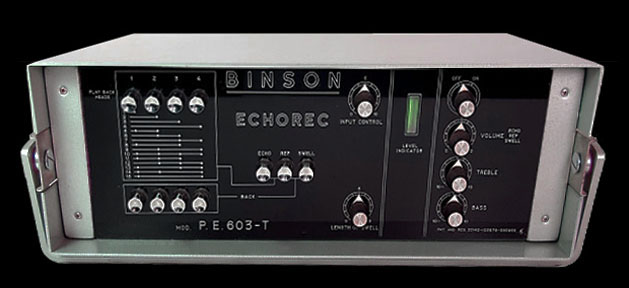
Binson Echorec PE 603 like the one Gilmour used from 1971-74 in his live rigs
David used various Echorec models but he was mostly known for using the Echorec 2 model T7E. The motor had a fixed speed so one turn of the drum equated to approximately a 300ms delay, but that could vary slightly depending on mains voltage, and volatage fluctuations. David bought an Echorec PE 603 model in 1971 that had a maximum delay time of around 377-380ms. It was used for the early live versions of On the Run in 1972, the third Money solo, and used on Pink Floyd tours until 1975. There were varispeed modifications that could be made to an Echorec to give it longer delay times, but it does not appear that David ever had this modification done to his units.
The Echorec 2 had six knobs - INPUT CONTROL (volume), LENGTH OF SWELL (number of repeats), VOLUME OF SWELL (volume of repeats), BASS/TREBLE (tone knob for the repeats), a three position SELECTOR knob, and a SWITCH knob that selected various combinations of the four playback heads. The SELECTOR knob had three positions: ECHO = one repeat, REPEAT = more than one repeat, and SWELL = outputs of the playback heads were fed back to themselves to create a spacey type of reverb effect. There were three input jacks on the side, and three input selector buttons on the front of the unit to select which input to use. The PE 603 Echorec had similar controls, but rather than having a switch to select different combinations of the four playback heads, it had individual switches for each head.
There is a misconception that David always used the Echorec for its multi-head function, but in reality he primarily used it in single playback head mode, just like any other typical delay. David did sometimes use the Swell mode, but that was rare. Below is a typical example using a single playback head of the Echorec 2. This is head 4 which is an approximate 300ms delay.
![]() Echoes chromatic riff with delay
Echoes chromatic riff with delay
One of the only clearly audible examples of the multi heads in use in a Pink Floyd studio recording is the intro to the song Time from Pink Floyds Dark Side of the Moon. You can also hear multi heads in a few early live Pink Floyd performances of Time and the four-note Syd's theme section from some performances of Shine on You Crazy Diamond. There are numerous modern delays that try to replicate this multi-head delay sound, like the Catalinbread Echorec, Strymon Volante, and Boonar Multi-Head Drum Echo from Dawner Prince Electronics, which David himself has used.
Below is an example of me using an Echorec style delay in a cover of Pink Floyd's 1969 song Dramatic Theme form the More album. I used a Free the Tone Future Factory delay set for 300ms and long repeats. I have a slight roll off of the high frequencies on the repeats to mimic the Echorec sound. As the song plays on I dial the delay volume and number of repeats higher and higher. The last 8 minutes of the song is a rambling collage of echo repeats. I demonstrate many of the unique sounds that can be created but playing repeating patterns in and out-of-tempo with the delay repeats, letting the repeats get to the point of self oscillating, tapping the strings with a glass slide, tapping the strings with my fingers and pick to create percussive effects, and rubbing my fingers and pick up and down the strings.
Below is a medley of David using the Echorec from 1969-1977. It covers all of the various ways he used echo - standard 3-4 repeat echo to make the guitar sound like it is in a large hall, using a slide like a violin with long delay repeats, slapback echo, swell mode, long repeats almost to the point of self oscillation, and what David calls "triplet" time, where he plays in time with the dotted eighth repeats.
Below are a few of the rare examples of David using the Echorec in multi-head mode from 1973 and 1975.
![]() Time intro - Isolated guitar from studio mix
Time intro - Isolated guitar from studio mix
![]() Time intro - Pink Floyd live in 1975
Time intro - Pink Floyd live in 1975
The Echorec playback heads were spaced so the input signal would repeat at specific intervals, adding delay repeats upon delay repeats. A 300ms and 380ms delay had the heads repeating in these specific delay times.
Echorec 2 .........................................Echorec PE 603
Head 4 = 300ms (or 75ms x 4) ..........Head 4 = 380ms (or 95ms x 4)
Head 3 = 225ms (or 75ms x3) ...........Head 3 = 285ms (or 95ms x 3)
Head 2 = 150ms (or 75ms x 2)...........Head 2 = 190ms (or 95ms x 2)
Head 1 = 75ms ..................................Head 1 = 95ms
If you look at head 4 as 4/4 time, the others would break down like this:
Head 4 = 4/4
Head 3 = 3/4
Head 2 = 2/4
Head 1 = 1/4
The type of multi-head repeats varied depending on which of the four playback heads were selected. The Echorec 2 had a 12 position switch to select among various combinations of heads. David usually used positions 1-4, for single playback repeats of heads 1-4. In live performances he usually used playback Head 4 for the maximum delay time of around 300ms. On the extremely rare occasions that David did use mulitple heads it was usually position 7, which was Head 3 + Head 4, 225ms + 300ms. Why is that important? Because later in his carreer David often used both a 3/4 delay, or what he calls a "triplet", and a 4/4 delay simultaneously, mimicking the sound of Heads 3 + 4 on the Echorec.
Gilmour's Binson Echorec 2 model T7E from 1970-71. Note the controls show playback mode switch is in position 4, which is single playback Head 4
Gilmour's Binson Echorec 2 model T7E from 1970-71 with the playback mode switch in position 4
Gilmour's Binson Echorec 2 model T7E from 1972 and 1977 with the playback mode switch in position 1, which is singe playback Head 1
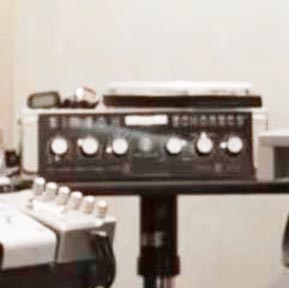
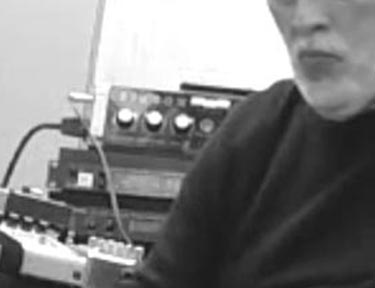
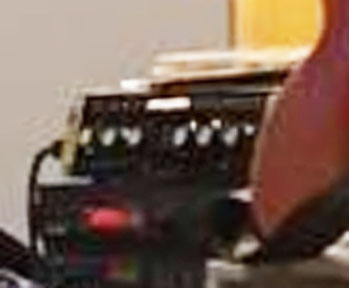
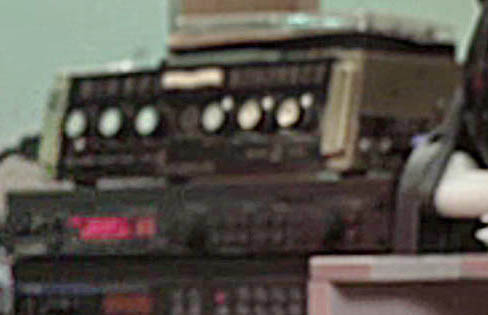
Various Echorec 2 settings seen in David's Medina studio from 2013, 2014, and 2017
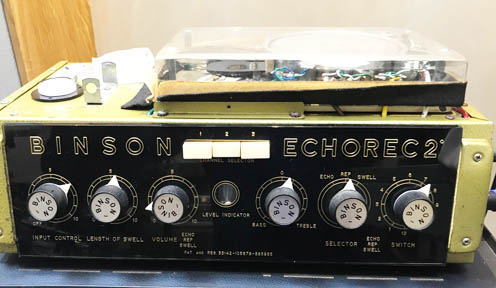
The Echorec 2 in David's Medina studio from 2017. The Mode switch is in position 7, which is Head 3 + Head 4
CATALINBREAD ECHOREC - One of my favorite simple Echorec style delays is the Catalinbread Echorec. There are several modern Echorec style pedals, including a few with more accurate playback head controls than the Catalinbread, but the Cat Echorec is a fairly no nonsense, simple to use version that sounds great.
Below are some specific Gilmour settings I use. I use several of the Program Select positions for various other things, but for Gilmour it's usually just position 1, 4, and 3. On the left is my standard setting range for the early 1970s Gilmour Echorec sound. Delay time depends on the era. Basically anything prior to 1977 is 300-310ms, which is the best delay time for the Echorec IMO, and Program position 1 is the standard for most DG solos from the Echorec period, equivalent to Switch Position 4/Head 4 on a real Echorec. Program Position 3 is equivalent to Switch Position 6 on the real Echorec, which is Head 3 + Head 2. Program Position 5 is equivalent to Switch Position 7 on the real Echorec, which is Head 4 + Head 3.
Adjust the tone to suit your amp/speaker tone.
Unfortunately the Catalinbread Swell control cannot be set as high as it needs to be for the Time intro, but it gets close. If you set it too high it will self oscillate into a whining feedback. Some of the other Program Select positions work for the Time intro too, like position 12. For the wet 1st and 3rd solos from Money I use basically the same settings, but I dial the mix knob up a bit for the third section after the dry solo. Using Program position 3 for that part also works. For the muted rhythm part in Echoes, Program 3 is the closest, but almost any program position works as long as the delay time is set for 300-310ms.
USING TWO DELAYS TO MIMIC AN ECHOREC - David stopped using the Echorec live after 1977. For the multi-head Echorec sound needed when performing the intro to Time and the four-note Syd's theme section of Shine on You Crazy Diamond he used two delays, and sometimes three! For example, when he played Time for Pink Floyd's 1994 tour he used a TC 2290 Digital Delay and the dual delays from a PCM 70 delay. For his 2015 tour he used a Providence Chrono Delay and two Flight Time delays. When he played Shine on You Crazy Diamond in his 2015 live performances he used three delays to replicate the old Echorec sound, two Flight Time delays and an MXR Delay. For most of his 2016 tour he used multiple delays for those parts, but switched to using a Boonar Multi-Head Drum Echo digital delay from Dawner Prince Electronics for the last few concerts.
I have managed to nearly replicate what a Binson will do using a combination of modern digital units…the multi-head sounds, as well as the Swell setting—which is what I use on the beginning of “Time,” for example - David Gilmour, Guitar World March 2015
You can use two delays in series (one after the other) or in parallel (each in a seprate signal path) to get David's multi-head Echorec style repeats. I think parallel is better than in series to mimic the Echorec because the one delay does not repeat the other, and the repeats can run longer without going into oscillation. However, setting the delays in series is easier for most people to do and it sounds just as good. Below is a simple video demonstration of Syd's theme using a Mojo Vibe (univibe clone) and two delays in series. The first delay is 275ms and second delay is 430ms.
Below is another video jamming with the Echorec style two-delay setup. The two delays and Mojo Vibe are set the same as the video above.
Below is an another example using two digital delays in series. It's fun to just jam around using the unique delay rhythm it creates.
![]() Using two delays to simulate the multi head Echorec effect - 470ms and 352ms
Using two delays to simulate the multi head Echorec effect - 470ms and 352ms
Below is an example of David using two digital delays (TC 2290 Digital Delay and the dual delays from a PCM 70 delay) for the intro to Time in 1994.
![]() Time intro - Torino, Italy, Sept 13, 1994
Time intro - Torino, Italy, Sept 13, 1994
Below is my best guess at the delay times David used there. The first delay is definitely set to 470ms, which is the 4/4 time. The second is around 94ms, which is 1/5 of 470 (470/5=94). The third delay is probably in 3/4 time, but I can barely hear it. The effect actually works fine with only two delays. I the clips below I play the 470ms delay first, then the 94ms delay, then both in series together.
![]() Time intro test - 470ms and 94ms
Time intro test - 470ms and 94ms
![]() Time intro test with backing track - 470ms and 94ms
Time intro test with backing track - 470ms and 94ms
The delays are set in series like this:
1st delay 470ms. Volume 65%
2nd delay 94ms. Volume 85%
8-10 repeats on the first delay and as many repeats as possible on the second, or as long as it can go without going into oscillation, which is around 3-4 seconds on most delays.
Below is an example from 2016 of David Gilmour using three delays to simulate the Echorec sound in Time. His delay times are slightly faster here.
![]() Time intro - Hollywood Bowl March 2016
Time intro - Hollywood Bowl March 2016
He used three delays there, but again, I can only distinctly hear two. Below are settings to get that sound. The primary delay sounds best when in time with the heartbeat tempo in Time, usually somewhere around 240 - 250BPM (beats per minute). That equates to 250 - 240ms. I use 240ms. If running the delays parallel, set for about 12 repeats on each. If running both delays in series, set the repeats however long you can go before oscillation starts, which is 8-10 repeats on most delays.
1st delay 240ms. Delay volume 90%.
2nd delay 165ms. Delay volume 50%.
That is an example where David seems to have set the delay speed by ear, rather than going by an exact Echorec formula. Divide 240 by 3 and you get 80. 80x2 = 160. 240ms and 165ms actually sound more like David's delay times, but there are other times that have the same feel. 234ms and 150ms also works.
Below is an example of the Syd's Theme section of Shine on You Crazy Diamond from Pink Floyd's 1994 tour. David is using two delays from a PCM70 rack delay to simulate the Echorec sound.
Below is an example of replicating the Syd's Theme delays from 1994. The tone is broken down to illustrate what each effect adds to the sound, in this order: Boss CS-2 compressor, Boss CE-2 chorus, Boss RT-20 Rotary Ensemble, FTT Future Factory stereo delay, BKB/Chandler Tube Driver.
![]() Syd's Theme 1994 - Effects Breakdown
Syd's Theme 1994 - Effects Breakdown
![]() Syd's Theme 1994 - 500ms and 375ms
Syd's Theme 1994 - 500ms and 375ms
The delays are set in series like this:
1st delay 500ms. Volume 65%
2nd delay 375ms. Volume 85%
8-10 repeats on each delay.
Below are examples from 2016 of David using three digital delays in series for Syd's theme from performances of Shine of You Crazy Diamond.
![]() Syd's theme - Hollywood Bowl March 2016
Syd's theme - Hollywood Bowl March 2016
![]() Syd's theme - Poland June 2016
Syd's theme - Poland June 2016
Again, I'll simulate that with only two dominant delays. The first delay is set to 570ms, which is the 4/4 time, and the second is set to 428ms, which is the 3/4 time. The delays are set in series like this:
1st delay 428ms. Delay volume 65%
2nd delay 570ms. Delay volume 85%
8-10 repeats on each. Here is my example of this sound.
Song tempos are rarely exactly the same every performance, but the SOYCD tempo is usually around 140 bpm. That equates to 428ms, which we will call the 4/4 time. How to you get the proper 3/4 delay time from that 4/4 time? Let's do some "Echorec math." 570 divided by four (4/4) is 142.5. Multiply that x3 to get the 3/4 time and you get 427.5. Or you can simply multiply the 4/4 time x75% and get the same 3/4 time. 570 x 75% = 427.5. This 3/4 and 4/4 delay can be used for more than just some Echorec effects. You can also play in time with the delays in a kind of shuffle rhythm. The clip below is played with those same 428ms and 570ms delay times. Both delays are in series with the delay volume around 75% and about 9 repeats.
![]() Echorec Style Delay Jamming - 428ms and 570ms
Echorec Style Delay Jamming - 428ms and 570ms
ONE OF THESE DAYS - One of the first recorded uses of Gilmour's "triplet" delay technique using a Binson Echorec was in the song One of These Days from Pink Floyd's Meddle album in 1971. It features two separate bass guitar tracks played in time with a single head delay (head 4) from the Echorec. David played the first bass guitar you hear and Roger Waters played the second that comes in immediately after. The delay time on head 4 was approximately 300ms, but it could vary depending on the mains voltage. It is around 294ms on the studio recording.
One day, Roger decided to take some of the techniques that I was developing and try them out himself on bass. He came up with that basic riff that we all worked on and turned into One of these Days. - David Gilmour, Guitar World magazine.
Below is an excerpt of David's bass guitar part, extracted from the 5.1 surround mix of Meddle.
![]() One of These Days - Gilmour bass excerpt
One of These Days - Gilmour bass excerpt
Below is a breakdown of how to play this effect. First you hear a single muted note picked with a 294ms delay set for 7 repeats (played twice). Then I play just the muted note rhythm so you can hear what it sounds without the delay, then I turn the delay on while playing. Although it is simple to play, you must play exactly in time with the delay or it will sound sloppy.
![]() One of These Days - 294ms delay
One of These Days - 294ms delay
HH IC-100 amplifier with built in tremolo
Another interesting effect heard in the middle section of One of These Days is the use of that same "triplet" time delay along with a gated tremolo effect. It created a unique stuttered stacatto rhythm. Gilmour used the same 294ms delay from the Echorec plus the built in vibrato from an HH IC-100 amplifier, which was a very choppy tremolo effect. David and Roger Waters each had one of these amps but I think the only other recorded example of it being used was for the BBC performance of Embryo in 1968. Gilmour used a similar gated tremolo effect for the sustained chords in the verse sections of Money, using the noise gate from an Allison Research Kepex (Keyable Program Expander) studio module, modulated with an external sine wave generator (according to engineer Alan Parsons).
For the middle section another piece of technology came into play: an HH amp with vibrato. I set the vibrato to more or less the same tempo as the delay. But the delay was in 3/4 increments of the beat and the vibrato went with the beat. I just played the bass through it and made up that little section, which we then stuck on to a bit of tape and edited in. The tape splices were then camouflaged with cymbal crashes. - David Gilmour, Guitar World magazine.
The IC-100 tremolo was set to maximum depth and the trem speed was set so there are two pulses for every delay repeat. Below is an isolated excerpt of this part.
![]() One of These Days - gated tremolo section isolated
One of These Days - gated tremolo section isolated
You can replicate the tremolo effect with any tremolo pedal, but it is best to use one the that has a square wave setting. "Square wave" means the sound wave looks square shaped, rather than wavy. The beginning and end of each tremolo pulse or "wave" is gated and clipped off, rather than ramping up and down like a soft wave. I use the Tremotron from Stone Deaf Effects for this. Below is a breakdown of how to play this effect. First is the delay, then the square wave tremolo, then both together. Then I play the bass rhythm clean, then with the effects on.
![]() One of These Days - 294ms delay + vibratto
One of These Days - 294ms delay + vibratto
MXR DIGITAL DELAYS - David began using digital delays in 1977. His first was an MXR 113 Digital Delay System, one of MXR's first rack effects. He then upgraded to an MXR Digital Delay System II. He used both in his 1980s live rigs, and continued to use the MXR System II up until 2016.
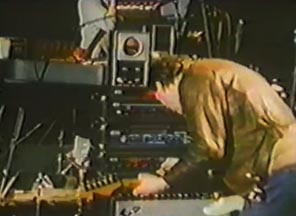
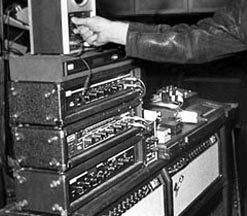
David Gilmour adjusting his MXR rack effects from April 1984, including the MXR 113 Digital Delay, and MXR Digital Delay System II
The MXR 113 was released in 1976 and David first used it for Pink Floyd's Animals tour in 1977. The repeats had a warm high end roll off, similar to David's Binson Echorecs. It also had delay width and frequency knobs in the Sweep section to add some chorus, vibratto, and flange effects, but I think David rarely used those, if ever. It had a maximum delay time of 320ms, but could be expanded to 1280ms by adding additional memory chips. The MXR Digital Delay System II was an upgraded version of the 113 that showed the delay time in milliseconds on the front panel and featured additional fine tuning controls. It had a maximum 16kHz bandwidth up to 800ms, with a maximum delay time of 1600ms, expandable to 3200ms. It also had a similar Sweep section to create chorus and flange effects, but every photo I can find showing this rack delay in David's live rigs shows the sweep knobs set to zero.
These were state of the art delays at the time, but were rather noisy effects compared to modern digital delays.
MXR Digital Delay System II showing David's knob settings
Part of the effects rack from David's 1994 Pink Floyd tour rig with the MXR Digital Delay System II mounted in the middle
David's MXR Digital Delay System II rack unit from the On an Island tour showing a note for
David's Echoes delay time of 300ms, one for the delay in Time, and 423ms in the display
RUN LIKE HELL - This is one of the standout tracks from Pink Floyd's The Wall double album, with music written by David Gilmour. It is a great example of what David calls "triplet time" delay playing, which is actually dotted eighth notes. The main rhythm guitar and chords are double tracked. The main delay rhythm that runs throughout the song is two guitars, one in the left channel and one in the right. Each was set to 380ms, around 7-8 repeats, with the delay volume almost equal to the signal volume. The sustained verse chords and chorus chords (the "run, run, run" part) were also double tracked with the same delay time, but slightly less repeats. The fill patterns played in the verse section sound dry, with almost no delay.
That may sound complicated, but to recreate the basic guitar parts all you really need is one digital delay set to 380ms. There are a few exceptions where David used two delays when playing it live, but he usually only used one.
![]() Run Like Hell Demo Instrumental - excerpt from The Wall demos
Run Like Hell Demo Instrumental - excerpt from The Wall demos
![]() Run Like Hell - Delay Rhythm Guitars Mixed Up Front - both channels
Run Like Hell - Delay Rhythm Guitars Mixed Up Front - both channels
![]() Run Like Hell - Sustained Chords Mixed Up Front
Run Like Hell - Sustained Chords Mixed Up Front
![]() Run Like Hell - Verse Fills Mixed Up Front
Run Like Hell - Verse Fills Mixed Up Front
It is not known exactly which delay David used for the sudio recording of Run Like Hell, but I do not think he used his Binson Echorec. I do hear what sounds like multi-head repeats in the chorus section of the first band demo however, so that could have been an Echorec. The maximum delay time of the Echorec 2 is not long enough for RLH, but David's PE 603 Echorec max delay time was 377-380ms, which is the RLH delay time. David also had an MXR 113 Digital Delay System that could do that delay time. The repeats in the RLH studio recording sound clear and clean, so the MXR was probably the delay used for that, and it was the delay used for the 1980-81 live performances.
David used his Workmate Esquire guitar for the studio recording, and usually used a Telecaster when playing it live. The amp David used for the RLH studio recording is not known, but presumably it was a Hiwatt or Mesa Boogie Mark I. To add some modulation and a spacious feel to the delay tone on the studio recording David used either a Yamaha RA-200 rotary speaker cabinet or an Electric Mistress flanger.
It's all on a D pedal. That came from an old trick I'd been using, which is having a DDL in triplet time to the actual beat. When you play across it, it helps you to double-track yourself. It has a certain feel, which sounds boring and ordinary if you put it in 4/4. If you put it in a 3/4 time it has an interesting bounce to it. Because the DDL keeps running along, you've got time to leave the pedal playing and play a couple of chords while the effects carry on - David Gilmour from Guitar for the Practicing Musician, January 1995
The delay time and your playing must be precisely in time with the song tempo, so it takes some practice to perfect this style of playing. For the delay, my favorite for this song is the old Boss DD-2, but any good digital delay will work. It helps to have a delay with a digital display that shows the delay time in milliseconds. There is a bit of light overdrive in the tone. I use a compressor or an overdrive with a light drive setting for this, such as a Tube Driver, Boss BD-2, or PastFX TD-Y.
For the guitar modulation, I use an old green 18v Electric Mistress, or a 1980s era Deluxe Electric Mistress in the big box. Electro-Harmonx has made a few small boxed versions of the Electric Mistress that also work, but those have a different sound thatn the originals. The Mooer Elec Lady is a good, inexpensive clone of the Electric Mistress that sounds better than the small boxed EHX offerings. The PastFX Elastic Mattress is an excellent clone of the old green Electric Mistress. A good chorus like the Boss CE-2 or CE-5 can also be used in place of the flanger.
![]() Run Like Hell Tone Building - Boss CS-2 compressor, Hartman Flanger, and two Boss DD-2 delays.
Run Like Hell Tone Building - Boss CS-2 compressor, Hartman Flanger, and two Boss DD-2 delays.
![]() Playing the RLH Rhythm Fills - with and without the delay
Playing the RLH Rhythm Fills - with and without the delay
![]() Playing the RLH Verse Chords - with and without delay
Playing the RLH Verse Chords - with and without delay
USING TWO DELAYS - David has stated he used two delays, one in 3/4 time (dotted eighth notes) and one in 4/4 time (quarter notes). The main rythm in the left and right channels of the studio recording is the 3/4 time delay. The 4/4 delay can barely be heard on the studio recording and is really not necessary, but it is fun to experiment with two delays. The 3/4 time delay is 380ms and the 4/4 delay time is 507ms, or one repeat on every quarter note (one beat). In the studio recording the 4/4 delay is not very obvious, so it was low in the mix, possibly only in one channel, or both. The original band demo, heard in The Wall Immersion Set, has a much bouncier, more disco-like feel, so I think the 4/4 delay is much more prominent in that mix. The 4/4 delay thickens space between the main delay repeats by double tapping your 3/4 repeat with a 4/4, creating a more bouncy rhythm. Alternately, you can use 380ms as the main delay and 285ms on a second delay, which is equivalent to Head 3 and Head 4 on a PE 603 Echorec. That creates a slightly different delay rhythm than the album sound, and more like David's mid 1980s RLH sound.
![]() Run Like Hell with 380ms and 507ms delay in series - first is 380ms delay in the left channel, then 380ms+507ms in the right channel.
Run Like Hell with 380ms and 507ms delay in series - first is 380ms delay in the left channel, then 380ms+507ms in the right channel.
For the mid 1980s RLH sound, you can set a second delay to 254ms, which gives three repeats for every beat. This adds a short, thick, ADT-like slapback sound to the main 380ms delay. You can hear this on David's 1984 live performances of Run Like Hell, as heard on the David Gilmour In Concert video released in 1984 by CBS, and the Westwood One Radio Network FM broadcast of the July 12th concert in Bethlehem Pennsylvania.
![]() RLH Intro live in 1984 - Live 1984_Hammersmith Odeon and Bethlehem Pennsylvania
RLH Intro live in 1984 - Live 1984_Hammersmith Odeon and Bethlehem Pennsylvania
![]() Run Like Hell with 380ms and 254ms delays in series - first is 380ms delay in the left channel, then 380ms+254ms in the right channel.
Run Like Hell with 380ms and 254ms delays in series - first is 380ms delay in the left channel, then 380ms+254ms in the right channel.
Below is my replication of that 1984 ADT sound using two delays in series to two different amplifiers, in stereo. The first delay is 380ms, 10-12 repeats, delay voume 95%. The second delay is set for 254ms, 1 repeat, with the delay volume set at 50%.
![]() RLH Intro live 1984 style - Boss CS3 compressor, Tube Driver, Boss CE3 chorus, Two Boss DD-2 delays, into a Twin Reverb
RLH Intro live 1984 style - Boss CS3 compressor, Tube Driver, Boss CE3 chorus, Two Boss DD-2 delays, into a Twin Reverb
That ADT slapback sound can also be heard on other Run Like Hell concert recordings, like Delicate Sound of Thunder, Pulse, and David Gilmour Live at Pompeii, but to a lesser effect.
If you want to try the two-delay effect on one amp, it is best to place the second delay after the main 380ms delay in your signal chain, and set the second delay repeat volume MUCH lower, with roughly 1/3 the repeats of the main delay. That second delay should just barely be audible, as too much volume can make a double tapped mess of the main delay. If using a 2 amp setup, you can try running one 380ms delay to each amp and keep the volume and delay repeats about the same for each, or you can run the 380ms delay to one amp and the 507ms dealy to the other for a slightly different feel to the stereo separation.
To determine a 4/4 delay time to work with any 3/4 triplet delay time, you can split the 3/4 time delay into thirds. For example, 380ms is your triplet time. 380 divided by 3 = 126.7ms. To get the 4/4 time delay, simply multiply 126.7 x 4 = 506.8ms.
You may also want to try setting the second delay at 760ms, double the triplet time delay (380 x 2 = 760ms). This creates sort of a triplet on top of a triplet time delay, adding a different bouncy feel to the delay rhythm. There are lots of different ways to use two delays at once for an integrated rhythm like this, so use your ears and experiment.
![]() Run Like Hell - band demo except
Run Like Hell - band demo except
Shown below are my Boss delay time settings to replicate the Run Like Hell band demo recording sound. The first is set in 3/4 time (dotted eighth notes) for about 8 echo repeats at exactly 380ms, or three repeats for every song beat. This is the primary delay time you hear in the song. The other delay is set in 4/4 time (quarter notes) at 507ms, or one repeat on every beat. Gear used: Telecaster into a fender twin Reverb and Reeves Custom 50, Boss CS-2 Compressor, Tube Driver set for light overdrive, Electro-Harmonix Electric Mistress, TC Nova delay.
![]() Example of Two Delays Run In Stereo - parallel delays, 380ms (both channels) and 507ms (right channel only), going to separate amps
Example of Two Delays Run In Stereo - parallel delays, 380ms (both channels) and 507ms (right channel only), going to separate amps
ANOTHER BRICK IN THE WALL PART I - This one is very similar to Run Like Hell, played in D, with a 450ms delay, around 7 repeats, with the repeat volume equal to the signal volume. The tempo is much slower, but the delay is played in 3/4 "triplet" time, exactly like RLH.
In the studio recording I hear one guitar playing the single note "triplet" time rhythm, a second guitar playing the fills, and a third guitar playing occasional accents on top of the fills.
![]() Another Brick in the Wall Part 1 - isolated guitars from studio recording
Another Brick in the Wall Part 1 - isolated guitars from studio recording
It is possible to play this on one guitar with one delay, as David did in Pink Floyd live in 1980-1981. You have to practice your timing so you can play the fills and get back to the D rhythm exactly in time with the delay repeats.
![]() Another Brick in the Wall Part 1 Live - isolated guitar from live recording
Another Brick in the Wall Part 1 Live - isolated guitar from live recording
You could also add a second delay in series to thicken the sound, combining the 3/4 time with a 4/4 time delay. The exact delay times would be 450ms for the 3/4 time and 600ms for the 4/4 time. The 450ms delay should come before the 600ms delay in your signal chain. Set the 600ms delay to half the repeats of the main delay, with a MUCH lower delay volume. That keeps you from getting a loud, double-tappy mess. The second delay should just be accenting the first, filling the space between the 3/4 repeats. Depending on your second delay EQ, you may need to experiment with the number of repeats and repeat volume.
BREATHE and GREAT GIG IN THE SKY SLIDE GUITAR VOLUME SWELLS - Breathe from Dark Side of the Moon features some beautiful David Gilmour slide guitar work. The notes fade in and out, like a pedal steel guitar. The slide parts actually were played on a pedal steel, a Fender 1000, but David just used it as a slide guitar and removed the foot pedals. The slide parts were made up of several multi tracked recordings, each playing slightly different, but similar phrases. The long delay, and multi tracked guitars add to the smooth, lquid feel of the notes. There is a 440ms delay on the guitars in the studio recording. A second and third guitar repeat similar slide phrases, playing slightly behind the first guitar. This gives the impression of a 920-930ms delay. David used a Binson Echorec for his delay at the time DSOTM was recorded, but the Binson cannot create a delay as long as 440ms. They averaged from 290-310ms. The studio recording was likely duplicated and played back 440ms behind the original guitar recording to create the effect, or the mixing board was outfitted with a longer delay to create the effect in the mix. The fact that these two delays were studio effects may explain why David never played the slide parts live in the original Dark Side of the Moon concerts.
The volume swells can be easily created today with a delay and a volume pedal. Place the volume pedal before the delay in the signal chain so when you drop the volume to zero the delay repeats still decay naturally. David would play a two note chord, then fade the volume in as he slides to the next position. You can also do the volume swells with the guitar volume knob, although it is much easier with a volume pedal. Set one delay for 440ms, 2 repeats, 30-35% volume. If you have a second delay, set that one in series to 930ms, 4-5 repeats, 30-35% volume.
![]() Breathe Intro Using Two Delays
Breathe Intro Using Two Delays
![]() Breathe Intro Using One Delay - One 440ms delay with 4-5 repeats also works well.
Breathe Intro Using One Delay - One 440ms delay with 4-5 repeats also works well.
Here is a breakdown from the Great Gig multi tracks. It plays through first with the guitar and delay, then plays through again with just the left channel dry guitar, then again with the right channel, which is a multi tracked guitar, but delayed behind the left channel guitar.
![]() Great Gig Slide Guitar Breakdown
Great Gig Slide Guitar Breakdown
Here's another, starting with the dry guitar in the left channel, then the right channel with the 440ms delay.
![]() Great Gig Slide Guitar Breakdown
Great Gig Slide Guitar Breakdown
SLAPBACK / ADT DELAY - It is not often, but ocassionally there is what sounds like a short slapback delay in Gilmour's guitar recordings, like the "dry" solo in Dogs from the Animals album. This may be a form of Automatic/Artificial Double Tracking (ADT) or simply a short slapback delay. It can be simulated with a short 40-50ms digital delay with one repeat, like this:
![]() Dogs Dry Solo with slapback delay
Dogs Dry Solo with slapback delay
PARALLEL MIXING DELAYS - Stacking one delay after another in your signal chain can degrade your tone because your original signal travels through, and is altered by, two delay circuits before coming out the other end. Also, two delays in line, while useful for some double tap delay effects, means that the repeats from the first delay are then repeated again by the second when both are used at the same time, which can sometimes create a mushy mess of repeats. To avoid this, and to keep the dry signal more pure, the delays in David's live rigs have sometimes been split off and run parallel with the dry signal, then mixed back together before going to the amp. He has used this type of setup in his 2006 On An Island tour rig. In 2006 the dry signal split off at the end of his pedal board signal chain into two separate loops, each going to a separate delay. Only the 100% wet delayed signal was returned from those two delays, into a mixer where the two were blended back with the dry signal before going to the amps.
Note that some people confuse mixing delays in parallel with "stacking" multiple delays or running a stereo setup with one delay going to one amp and another delay going to different amp. Those are not the type of parallel setup we are talking about here. Below are examples of a few ways to set up the type of parallel signal chain used in Gilmour's rigs.
The delay used must have a "kill dry" or "dry defeat" mode, which means ONLY the 100% wet delay signal is sent to the output of the delay, none of the dry signal. If your delay does not have a dry defeat feature, it is pointless to use in a parallel setup. Some delays that can do this are the Boss DD2/3, TC Electronics Nova Delay, Providence Chrono Delay, Boss DD20, Free The Tone Flight Time, Eventide Timefactor, Strymon Timeline, Empress Super Delay, EHX Deluxe Memory Man, TC 2290, MXR Delay System II, and many others. There are several parallel looper pedals that can be used for the actual "looping" part of the setup. Sometimes these are called "parallel mixers" or "looper" pedals. The Boss LS-2 Line Selector, Xotic Effects X-Blender, Lehle Parallel, and Badger Schism are a few that do the job.
SOUND-ON-SOUND - David Gilmour had a special Sound-on-Sound (S-O-S) rig built for performing the intro to a new acoustic version of Shine On You Crazy Diamond for his 2001-2002 Meltdown concerts and he used this same rig for his 2006 tour. The S-O-S rig allowed him to play sustained chords on the guitar which he could then play melody on top of. For David's 2006 rig one output from his Mk 2 Cornish-built pedalboard went to his main Hiwatt amp and 4x12 speaker cabinets. The other output went to a Sound-on-Sound interface built into David's rack, which fed a second Hiwatt amp and 4x12 speaker cabinet. The S-O-S unit was basically a buffered interface with two send/returns. The first send went to a volume pedal. The second send went to a Roland SDE 3000 digital delay in his rack, with individual level controls for both the send and return, along with a mute switch. The SDE 3000 was set for a 1500ms delay, giving approximately 20-30 seconds of regenrated delay repeats.
David would play a chord, raise the volume pedal to send the signal into the SDE 3000, then lower the volume back to to zero to kill the input signal. That delayed chord would ring on through the second Hiwatt for approximately 20-30 seconds before decaying, simulating a sustained keyboard chord. As the chord rang on, David could then play the melody lines through his main Hiwatt. He would do this for each chord change in the intro to Shine On You Crazy Diamond, effectively doing both the keyboard and guitar parts all by himself.
REEL-TO-REEL SOUND-ON-SOUND - David did an early version of sound-on-sound way back in October of 1970, in one of the few times Pink Floyd performed Alan's Psychadelic Breakfast live. What is interesting about this performance is that it is probably the only time David is known to have used a tape delay. He has a 2.2 second delay on the guitar so he can play over his repeats, building up layer upon layer of guitar repeats. David's T7E and PE603 Echorecs, and even the stock Echoplexes at the time, were not capable of anything even close to that length of delay. This was most likely a reel-to reel recorder set up for a tape-loop delay. This would not only be one of the only times David is known to have used a tape delay effect live, but he seems to have used it much earlier than other guitarist more well known for this effect. Brian May (of Queen) did the same effect a few years later on Brighton Rock and Son and Daughter using his modified Echoplexes. He became known for this effect as he used it for his guitar solo in practically every queen concert. Brian Eno did something similar later in the early-mid '1970s with his famous reel-to-reel frippertronics tape delay effect.
![]() Alans Psychadelic Breakfast with 2.2 second tape delay_Oct 1970
Alans Psychadelic Breakfast with 2.2 second tape delay_Oct 1970
THE BOSS DD-2 DELAY - The 1983 Boss DD-2 was one of the first, and best sounding digital delays to come out of the early days of digital effects pedals. It was my very first delay and one of my favorite pedals for Gilmour-ish delay. David used the DD-2 extensively in the mid to late 1980s, as well as using a Pete Cornish Tape Echo Simulator (TES) in 2006, which was a Boss DD-2 circuit with a selectable roll-off filter added to simulate the worn tape head sound of old tape delays like the Binson Echorec. A DD-2 was also seen in David's Medina studio around 2017. Shown below are some typical Gilmour DD-2 delay times. The Effect Level (volume) and Feedback (number of repeats) will vary. The mode should always be set at 800ms, unless you want a short slapback delay for something like the dry solo in Dogs.
Even though the DD-2 delay chip only produced a 12 bit sample, the circuit blended part of the clean signal back in, producing a crisp, accurate digital repeat. It still retained the warmth of the original signal rather well, but there is no high end roll-off in the repeats, so it is not "warm" analog delay in that regard. The repeats are bright and shimmery but not brighter than the original signal. When using both the mono and stereo outputs together (each running to a separate amp) the DD-2 produces a very defined stereo field, with one channel being the dry signal only, and one being the delayed signal only. The early Boss DD-3 pedal had exactly the same circuit as the DD-2. When the IC chips became less expensive to manufacture Boss simply rebranded it as a new, lower priced version rather than lowering the price of the DD-2. Later versions of the DD-3 have different circuits.
Kit’s Secret Guitar, Gear, and Music Page
Guitar stuff, gear stuff, soundclips, videos, Gilmour/Pink Floyd stuff, photos and other goodies.
Copyright Kit Rae.
VISIT MY SWORDS, KNIVES and FANTASY ART WEBSITE www.kitrae.net

